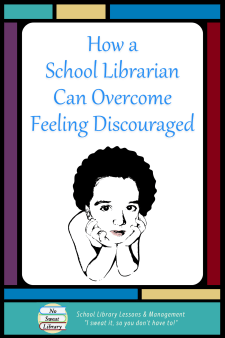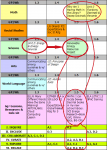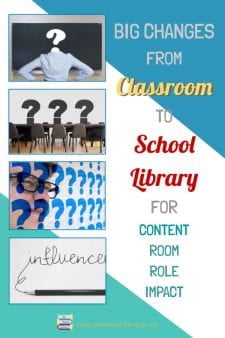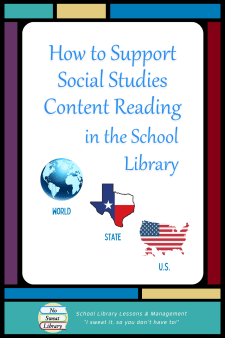 School Librarians work hard to promote reading, especially of fiction books (as in organizing fiction by Subjects), to support the English Language Arts curriculum.
School Librarians work hard to promote reading, especially of fiction books (as in organizing fiction by Subjects), to support the English Language Arts curriculum.
However, we know that students learn and retain more when they have rich content-area background knowledge, so it makes sense that we work just as hard to encourage students to read curriculum-related books in support of other content areas.
When Kathy Cunningham, a fellow district librarian at Blalack Middle School in Carrollton Texas, showed me how she had grouped books to support the Social Studies curriculum, I was inspired to do the same. Our school library now has three Special Collections for Middle School Social Studies that contain fiction and non-fiction books:
- Globetrekkers for 6th grade World Cultures
- Totally Texas for 7th grade Texas State History
- Read America for 8th grade U.S. History through Reconstruction.
To make it easy for students to find them and for library aides to shelve them, I added unique identifier labels below the spine labels, then located them so they were distinct from other books, yet still part of the main library collection. Follow along as I explain how I chose books and created our Special Social Studies Collections.
GLOBETREKKERS – 6g World Cultures
To identify fiction books I ran reports by Subject for each continent and its countries. For nonfiction, I pulled Dewey books off the 000-999 shelves that related to countries and cultures. I didn’t include any folktales because 6g ELA teachers do a multicultural folktale unit, nor did I include country “facts” books from the 900s, but I did pull any cultural and natural wonders titles found there.
Our students study countries by continent, so I created and attached a colorful continent label under the spine label. (My friend used Demco’s color-striped circles mounted horizontally to simulate a flag.) To make them even more distinct from the regular collection, I also added a Demco transparent color-tinted circle on the spine label—as a “globe”—using pink for fiction and teal for nonfiction.
I located the GlobeTrekker collection on recently installed shelving near the door to the 6g hallway. It was especially gratifying for me to see kids checking out newly labeled cultural books from the 300s, art books from the 700s, and natural wonders from the 900s that were “invisible” in their original locations. Kids told me how much they liked all the “new” books I’d gotten for them!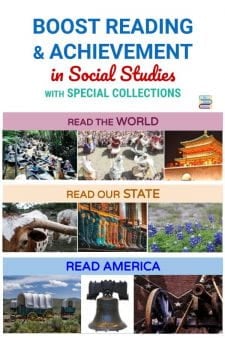
With so many 900 cultural books moved to the GlobeTrekker section, I had room to place all the non-U.S. country books together in a single aisle, that is, I moved the 980s & 990s to the end of the 972s. I placed a colorful sign atop each segment of shelves to clearly identify the Continent and added shelf labels to identify the country numbers. The kids don’t notice the jump in numbers from 972 to 980 (I did put a sign there to indicate that all 973 U.S. books are in the next aisle.), but browsing for country books in a single aisle is so much easier that students are now reading them more.
TOTALLY TEXAS – 7g State History
To increase the 976.4 Texas Dewey section, I added Texas-related books from 000s-800s, including Texas folktales, as well as some short Texas biographies. (I did change books on Texas cultures, folklore, food, & music to Texas Dewey numbers.) As explained above, moving 980-999 books to the 900-972 aisle opened up extra shelves after 976.4 so there was plenty of room to add the additional 976.4 Texas History books.
 Most of the Texas Dewey books had already gotten a Texas outline label under the spine label to differentiate them within the larger Dewey collection, and the Texas Fiction books—stories that take place in or deal with Texas—had gotten the outline label and a dark green color-tinted label protector on top of the spine label when the fiction area was reorganized into Subjects. So I just added a transparent green star—for the “Lone Star State”—on the Dewey book spine labels.
Most of the Texas Dewey books had already gotten a Texas outline label under the spine label to differentiate them within the larger Dewey collection, and the Texas Fiction books—stories that take place in or deal with Texas—had gotten the outline label and a dark green color-tinted label protector on top of the spine label when the fiction area was reorganized into Subjects. So I just added a transparent green star—for the “Lone Star State”—on the Dewey book spine labels.
Our Fiction area begins right across the aisle from the Dewey 900s, so I moved Texas Fiction to shelves across the aisle from 976.4, thus bridging Texas Dewey & Texas Fiction to make the end of that aisle truly Totally Texas. Seventh graders quickly discovered the new section, and just like with 6g, the 7g kids were checking out books they’d never noticed before!
Middle schools in Texas don’t study individual states (except Texas) and there was little interest in them, so all non-Texas state books were donated to one of our elementary feeder schools. There are now no 974-976.3 nor 976.5-979. Since current states info can be found from an online subscription service, the loss is negligible. Removing those books opened up space for an expanded 973 U.S. History section.
READ AMERICA – 8g U.S. History
When I got rid of the individual state books, I did keep those that were topical to overall U.S. History and changed their call numbers to a 973 number. All the U.S. History books are now together by geography or by historical period.
- Books about natural wonders, historical landmarks, and national or state parks were changed to 973.091, the DDC number for geographical treatment.
- Books about the 13 original colonies became 973.2 Colonial America with their 2-letter State Postal Code instead of author letters.
- Books about significant U.S. events, like westward expansion and September 11 were changed to their historical time period in 973.2-973.9.
 Our Fiction books for the time periods studied in 8g U.S. History had already been labeled with an Historical America sticker, but I wanted to “bridge” them as I had with the Texas fiction and nonfiction. They were moved to shelves next to Texas Fiction and now the Historical America fiction books are across the aisle from the 973 U.S. History Dewey books.
Our Fiction books for the time periods studied in 8g U.S. History had already been labeled with an Historical America sticker, but I wanted to “bridge” them as I had with the Texas fiction and nonfiction. They were moved to shelves next to Texas Fiction and now the Historical America fiction books are across the aisle from the 973 U.S. History Dewey books.
To really promote the Read America and Totally Texas Social Studies Special Collections, I hung a huge U.S. map on the wall at the end of the aisle, and created signage and shelf labels to identify our new “American History & Historical Fiction” aisle. Students are checking out more of these books than ever before!
PROMOTING SPECIAL SOCIAL STUDIES COLLECTIONS
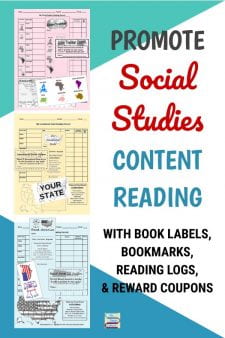 To promote the reading of GlobeTrekkers, Totally Texas, and Read America, I created special bookmarks for student comments while reading, along with Reading Records for students to paste into their Interactive Notebooks to record books read. When students reach their book reading goal—which varies by grade level—they receive a Social Studies coupon to add 5 points to any Social Studies quiz…a reward suggested by the Social Studies teachers.
To promote the reading of GlobeTrekkers, Totally Texas, and Read America, I created special bookmarks for student comments while reading, along with Reading Records for students to paste into their Interactive Notebooks to record books read. When students reach their book reading goal—which varies by grade level—they receive a Social Studies coupon to add 5 points to any Social Studies quiz…a reward suggested by the Social Studies teachers.
I’ve packaged these up for you in No Sweat Library, my TeachersPayTeachers store.
Look them over!
The real pièce de résistance was when the Social Studies teachers asked to have a special “orientation” for the new Social Studies Special Collections! Here’s a synthesized slide presentation I gave to introduce each grade level’s Social Studies classes to their Special Collections.
MAKE IT EASY BY KEEPING IT SIMPLE
Because both fiction and nonfiction books for the GlobeTrekkers collection were pulled from so many different Dewey numbers and fiction subjects, I did change their Home Location in the automation system to Global, which my colleague had created for her special collection. Otherwise, except for the few Dewey number changes to Texas books and some 973s, the beauty of this process has been simply adding classification labels and transparent color-tinted label overlays—no call number or spine label changes!
As with my reorganization of the Fiction area into Subjects (genres), should the next librarian want to eliminate these special collections, removing the labels is pretty much all that’s needed.
So, School Librarians: surprise your Social Studies teachers and students with Special Collections to support their subject-area content. Students will increase their background knowledge and you will garner praise for contributing to increased student achievement!




